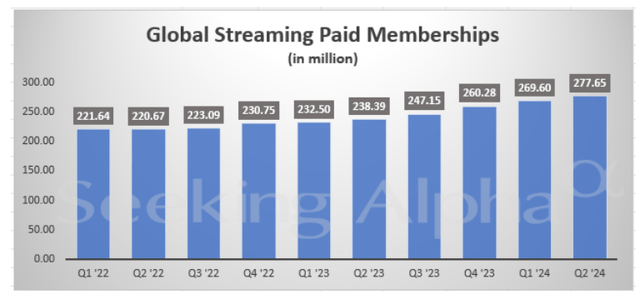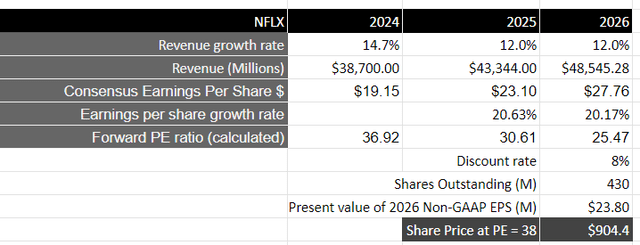Netflix On Discount: Ads Boost, ARPU Growth Not Priced In
Summary:
- Netflix stock is up 45% YTD, and I see a 27% upside with a price target of $904 due to its discounted valuation and projected strong ARM growth.
- The ad-supported tier will drive customer acquisition at low entry points, while higher ad spend on the platform from advertisers should boost both top and bottom lines.
- In the meantime, its ad-free membership continues to show strength, especially with the superior content strategy of Netflix as it innovates across Series, Film, Games and Live Sports.
- Although competitive threats remain, Netflix is positioned for further upside ahead as it builds out its ad business while driving a highly engaging content slate, thus unlocking operating leverage.

Riska
Introduction and Investment Thesis
With Netflix (NASDAQ:NFLX) stock up 45% YTD, outperforming both the S&P 500 and Nasdaq 100, I believe that there is room for more upside.
27%, to be precise, with my price target of $904.
As the stock trades at a discount of close to 21% to its 5-year forward price-to-earnings ratio, I believe that Netflix will continue to see strong growth in its Average Revenue per Membership (“ARM”), as it builds out its ad-supported tiers to attract both users at a low-cost entry point and advertisers. This will create a flywheel effect of revenue that is no longer constrained solely by the number of subscribers, along with a growing operating leverage.
This is not to say that its ad-free tiers are disappearing any time soon. On the contrary. In fact, its ad-free tier continues to see a strong growth rate in paid member additions and will do most of the heavy lifting to overall revenue growth in the short-term period.
However, as Netflix builds out its ad business, I expect less attention will be paid to subscriber count as its ad-supported tier will generate revenue per user based on the number of ads watched.
Although there are competitive threats from the likes of YouTube (NASDAQ:GOOG), Disney (DIS), and Amazon (AMZN), along with emerging FAST (Free Ad Supported Television) channels like Roku Channel (NASDAQ:ROKU) and Fox affiliate Tubi, I believe Netflix maintains a superior position given its content strategy, where it is innovating not only across Series and Film, but also expanding into games and live sports.
Assessing both the “good” and the “bad,” I believe the stock is well positioned to continue to drive upside from its current levels. Therefore, I will be initiating a “buy” rating with a price target of $904.
Growing engagement with an impressive content slate
Netflix reported its Q2 FY24 earnings, where it saw its revenue grow 17% YoY to $9.55B, beating estimates as the company continued to deliver a wide variety of hit series like Bridgerton S3, Baby Reindeer, Queen of Tears, and more, leading to a 16% YoY growth rate in average paid memberships to 277.65M.
In terms of geographic distribution, UCAN (United States and Canada) drives close to 30% of Total Paid Subscribers, growing 11% YoY. Meanwhile, paid memberships grew at a faster rate in its EMEA, LATAM, and APAC geographies that contributed the remaining 70% of Total Paid Subscribers, with EMEA contributing over 33% to Total Paid Subscribers.

Seeking Alpha: Growth in Global Streaming Paid Memberships
However, it is worthwhile noting that it is the UCAN market that commands the highest Arm at $17.17, growing 7% YoY, while its remaining geographies actually saw a decline in ARMs on a year-over-year basis.
Looking at the big picture, the company continues to expand their entertainment offering to expand their reach, recommendations, and fandom on the platform, given its dominance in streaming TV watch time in the US. Plus, the management also noted in its Shareholder Letter that Netflix currently accounts for just 6% of its total estimated market cap of $600B across streaming, pay TV, films, games, and branded advertising, which gives it plenty of whitespace to continue growing into. Particularly, India was their Number 2 and 3 country in terms of paid net adds and revenue percent growth, respectively, helped by big, successful titles showcasing that Netflix is continuing to appeal to many different tastes with high-quality storytelling.
Last month, Jefferies also issued a bullish note saying that the company could possibly raise prices for its streaming plans towards the end of the year on the back of highly anticipated content releases.
“We believe NFLX has been positioning itself throughout this year for a year-end price hike. December/2025 will have major content releases supporting a pricing increase, including the Christmas NFL game, Squid Game 2 on Dec. 26th, WWE Raw starting Jan 2025, and Stranger Things 5 coming in 2025,” Jefferies said in their flash note dated August 5.
While the above note aligns with the management raising its FY24 revenue guidance by 50 basis points to 14.5% YoY growth rate, it is also worth noting that not everyone would like to commit to a costly ad-free subscription. This is where Netflix’s ad tier comes in to mitigate churn as well as eliminate its dependence on subscriber growth rates, which is what we will discuss in the next section.
Ad-supported tier shows promise, but competitive threats to watch out for
To provide a quick context on Netflix’s ad tier, Netflix’s co-founder and former CEO, Reed Hastings, had been vocal against ads on the platform, going on record multiple times to advocate against ads on the platform. However, in 2022, he finally backtracked on his stance and launched an ad-supported plan after the stock fell at least 70% from peak to trough as subscriber count stalled and profit margins shrank.
At the same time, an intriguing trend in Nielsen’s Gauge report is the emergence of a new brand of TV channels that a growing number of users are flocking to. FAST or Free Ad-Supported Television channels, such as Roku Channel and Fox affiliate Tubi, had been steadily rising since the pandemic, but the share of viewing minutes on these FAST channels spiked by over 50% for many channels in the past 12 months. Alternatively, other users have continued to flock to YouTube as well, the free version of which loosely offers the same value proposition as many FAST channels.

Q2 FY24 Shareholder Letter: Share of US Screen time from Nielsen
Meanwhile, in order to get a pulse of how Netflix is making progress on its ad-supported tiers, its ad-tier membership grew 34% quarter on quarter, enabling them to not only offer lower prices to consumers ($6.99 a month in the US), but also create an additional revenue and profit stream for the business. Meanwhile, they continue to improve the services they offer to advertisers, making it easier for clients to plan campaigns and understand their audiences on Netflix, with brands like Expedia, Coca-Cola, Ford, L’Oréal, and McDonalds testing out their “pause ad” campaigns. On the programmatic side, Netflix is also expanding capabilities to include The Trade Desk (NASDAQ:TTD), Google DV 360, and Magnite, which should ideally position them to achieve critical and subscriber scale for advertisers in their ad countries by 2025, which therefore creates the foundation to spearhead ad membership growth from then onwards, making it a larger contributor to overall revenue.
Remember, when it comes to its ad-free tier, Netflix’s revenue is limited to the membership value it charges its users. On the other hand, in its ad-supported tiers, Netflix’s revenue is not constrained to the lower subscription value it charges its users. On the contrary, if an ad-supported user watches more Netflix with ads, it can potentially lead to higher ARM, boosting both the top and bottom lines.
Tying it together: Further upside ahead
Looking forward, Netflix is projected to grow its revenue by approximately 14.5% YoY to $38.7B, with an operating margin of 26%. Taking the consensus estimates into account, we should expect the company to continue growing in the low to mid-teens in the coming years as it builds out its ad-supported tiers to help advertisers better target relevant users while acquiring users at a lower price point than their ad-free tier. This should create a flywheel effect as advertisers start to allocate higher spend on the platform with growing return on ad spend, which will ultimately result in higher ARM, boosting top-line growth. In the meantime, I expect steady performance in membership growth in its ad-free standard plans, especially given Netflix’s existing and emerging content areas of streaming live sports and games, which should support its pricing power.
From a profitability standpoint, taking the consensus estimates for non-GAAP EPS of $27.76 in FY26, we see that its earnings per share will be growing at a faster rate than overall revenue growth, which, I believe, will be possible as the company improves its operating leverage by growing its ARM across both its ad-supported and ad-free tiers during this period of time. This will be equivalent to a present value of $23.80 in non-GAAP EPS when discounted at 8%.
Taking the S&P 500 as a proxy, where its companies grow their earnings on average by 8% over a 10-year period with a price-to-earnings ratio of 15-18, I believe that Netflix should be trading at roughly 2.25x the multiple given the growth rate of its earnings during this period of time. This will translate to a PE ratio of 38, or a price target of $904, which represents a downside of 27-28% from its current levels.

Author’s Valuation Model
My final verdict and conclusions
Netflix is currently trading at a 21% discount to its 5-year forward price-to-earnings ratio. In the meantime, I am optimistic about its growth trajectory ahead with its ad-supported tiers. While its ad-free tier will continue to do most of the heavy lifting in terms of its contribution to overall revenue in the short-term period, until Netflix fully builds out a robust ad ecosystem, in the longer term, its subscriber count will be slightly less under focus, as its revenue will no longer be constrained by it. Instead, with the right ad targeting infrastructure in place, Netflix has a real opportunity to spearhead user acquisition at a faster rate, given the low subscription price of ad-supported tiers, while scaling its ARM with better targeted ads.
As a result, I am initiating my “buy” rating with a price target of $904, which implies an upside of 27-28% from its current levels.
Analyst’s Disclosure: I/we have a beneficial long position in the shares of AMZN either through stock ownership, options, or other derivatives. I wrote this article myself, and it expresses my own opinions. I am not receiving compensation for it (other than from Seeking Alpha). I have no business relationship with any company whose stock is mentioned in this article.
Seeking Alpha’s Disclosure: Past performance is no guarantee of future results. No recommendation or advice is being given as to whether any investment is suitable for a particular investor. Any views or opinions expressed above may not reflect those of Seeking Alpha as a whole. Seeking Alpha is not a licensed securities dealer, broker or US investment adviser or investment bank. Our analysts are third party authors that include both professional investors and individual investors who may not be licensed or certified by any institute or regulatory body.
I am Amrita and I write primarily about growth software stocks.
I recently joined The REIT Forum and if you are looking for more investment ideas like this one, get them exclusively at The REIT Forum with access to our subscriber only portfolios.

